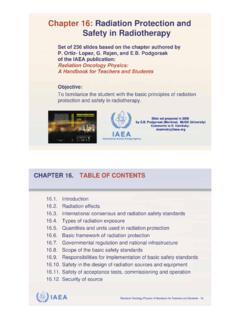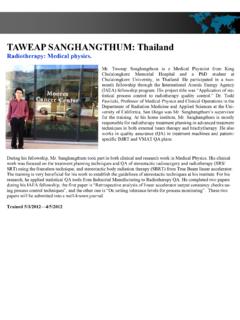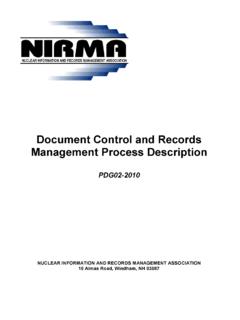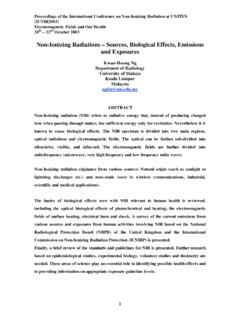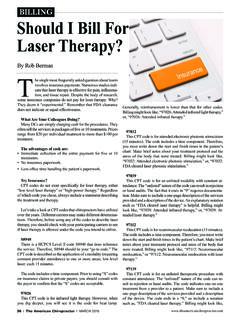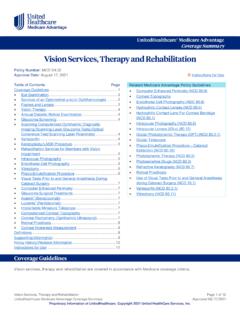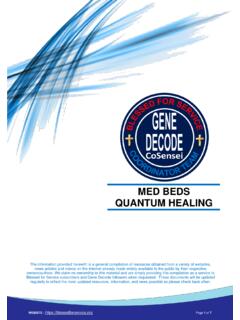Transcription of Radiation Vault Design and Shielding
1 Radiation VaultDesign and ShieldingRajat Kudchadker, PhDAssociate ProfessorDepartment of Radiation PhysicsThis report addresses the structural Shielding Design and evaluation for medical use of megavoltage x- and gamma-rays for radiotherapy and supersedes related material in NCRP Report No. 49, Structural Shielding Design and Evaluation for Medical Use of X Rays and Gamma Rays of Energies Up to 10 MeV, which was issued in September descriptive information in NCRP Report No. 49 unique to x-ray therapy installations of less than 500 kVand brachytherapy is not included in this Report and that information in NCRP Report No.
2 49 for those categories is still therapy simulators are not coveredin this report and the user is referred to the recent Report 147 for Shielding of imaging Report No. 151 New Issues since NCRP # 49 New types of equipment with energies above 10 MV Many new uses for radiotherapy equipment Dual energy machines and new treatment techniques Room designs without mazes Varied Shielding materials including composites More published data on empirical methodsNCRP Report No. 151 New ModalitiesNew modalities include: Cyberknife Robotic arm linacs No fixed isocenter All barriers except ceiling are primary Uses only 6 MV Helical Tomotherapy Radiotherapy CT Uses only 6 MV Uses a beam stopper Serial Tomotherapy MIMIC device attached to conventional linac Uses table indexer to simulate helical treatment OutdatedSpecial ProceduresNew modalities include.
3 Intensity Modulated Radiation therapy (IMRT) Usually at 6 MV Leakage workload >>primary, scatter workload Could be >50% of the workload on a linac Stereotactic radiosurgery Use factors are different from 3D CRT High dose, however long setup times Total Body Irradiation (TBI) Source of scatter is not at the isocenter Primary, leakage workload is greater than prescribed doseIncreased data for: neutron production capture gamma rays scatter fractions scatter albedo activation laminated barrier IMRT efficiency factorsNCRP Report No. 1511)Introduction (purposes, units, basic principles)2)Calculation Methods3)Workload, Use Factor and Absorbed-Dose Rate Considerations4)Structural Details5)Special Considerations (skyshine, side-scatter, groundshine, activation, ozone, tomotherapy, robotic arms, IORT, Co-606) Shielding Evaluations (Surveys)7)Examples (calculations)Appendix A.
4 FiguresAppendix B. TablesAppendix C. Neutron MonitoringNCRP Report No. 151 NCRP 151 - Terminology P: Weekly Design dose limit (Sv/wk) d: Distance from target to measurement point W: Workload (Gy/wk) U: Use Factor T: Occupancy Factor a: Scatter fraction ( ,E) dsec:Distance from scatterer to measurement point dsca:Distance from target to scatterer Dl: Distance from target to measurement point F: Area of the beam in the plane of scatterer (cm2) B: Barrier transmission factorShielding Goals Aim 1: to limit Radiation exposure of staff, patients, visitors and the public to acceptable levels Aim 2.
5 To optimize protection of patients, staff and the public Different considerations are required for: superficial/orthovoltage X Ray units simulators, CT cobalt 60 units linear accelerators brachytherapyDesign Process Designate architect, planner, coordinator Define Design team Participants ( Owners .. there are different levels of ownership) Planning questionnaire Program objectives Functional space program Spatial relationships of functions (review space function, block diagram, floor plan, etc.) Specifications (Systems, equipment, Shielding , vendors) Plan review and acceptancePhysicists are important members of the Design teamShielding - Planning and Layout When planning a new facility assumptions must be clearly stated, verified and documented Conservative assumptions should be used as under- Shielding is significantly worse (and more costly)
6 Than over- Shielding Plan for the future - consider expansions and increase in workload - The Design should be adequate for the next 20 years including room for expansion Megavoltage treatment rooms are typically in the basement It is best to place bunkers together to use common walls Size matters - bunkers should be generousPlanning and LayoutLinac 1 Linac 2 Linac 3 Linac 4 Planning Activities Site visit to other facilities Design Team: technologists, therapists, physics, physicians, administrators Facility Design aspects with architects Equipment decision and specifications with vendors Equipment routes to rooms for installation - riggers Specific room layouts, Shielding consultant/specification Planning for the future: potential and unknowns Clustering/segregation of areas Communication and review of all plans Requirements.
7 State, local building codes, Rad Prot regs Timeline for planning and constructionEquipment Selection Actively participate in recommending beam energies Most patients treated with IMRT/VMAT these days Do we really need beam energies >10 MV? 18 MV: D=10 cm %DD(10x10 cm2) = 80% 15 MV: D=10 cm %DD(10x10 cm2) = 77% 10 MV: D=10 cm %DD(10x10 cm2) = 75% Neutron production 18 MV: Sv/Gy at isocenter 15 MV: Sv/Gy at isocenter 10 MV: Sv/Gy at isocenter Almost 40 times neutron production at 18 MV vs. 10 MV 3 -4 greater polyethylene in doors (700 lbs = $$$)Keys to Successful Planning Well written device specifications radiological treatment and imaging devices, their receipt, installation and acceptance testing Well written Shielding specifications Shielding materials, thicknesses, shielded door mechanical and radiological properties, materials and components to match specifications (eg.)
8 Concrete density 147 lb/ft3or gm/cm3) Ask to be consulted on any potential changes on vendors for any radiological devices or components As physicists, be innovative to help solve problems Never revise anyone else s space without permissionPossible Problem Areas Net versus Gross space use templates Specification of shielded doors mechanical and radiological parameters Wall penetrations: signal cables, network, utilities, Design /layout of operator control areas Laser wall-mounting systems Signage, Interlocks, etc. Route for equipment entry (size and weight) Lead versus concrete Shielding Room accommodations for the future Designation of utilities chases always eat up space in the endShielding Design Approach Obtain a plan of the treatment room and surrounding areas (it is a 3D problem!
9 !!) how accurately are wall and ceiling materials and thicknesses known when in doubt, measure what critical areas close imaging patient waiting areaCross sections are helpful to see adjacent areas/roomsInformation Required Equipment type Treatment techniques Workload Target dose and dose rate Use factor and direction of primary beam Distance to the area of interest Occupancy of area to be shielded Dose limit value in area to be shieldedLinac: Facilities Considerations Power -high electrical power consumption, power quality critical. Cooling Water -specific requirements per manufacturer. Compressed Air -some systems require this as well.
10 Air Conditioning Routing all of the above into the room is complicated by Shielding needs Alignment lasers -rigid mounting critical Video monitoring Audio intercom Radiation monitorShielding Considerations Make sure that all room penetrations are correctly dimensioned and positioned on the plans, for example doors windows utilities electrical plumbing dosimetryRoom Location Is the room controlled or uncontrolled area? accessible to working staff only? accessible to patients or general public? adjacent to low occupancy areas (toilet, roof)?Equipment Placement Minimize Shielding requirements by placing it near low occupancy walls using distance to best advantage (inverse square law) Check if there is enough space around the equipment for Safe operation Servicing Patient treatment aids QA equipment Imaging equipment Stretcher/wheelchairShielding Design Regulations Must be designed by a qualified Radiation expert The role of the licensee and the regulator.
